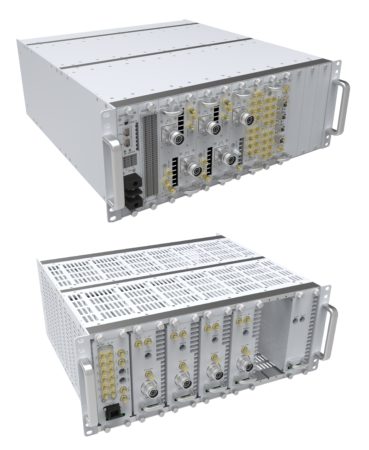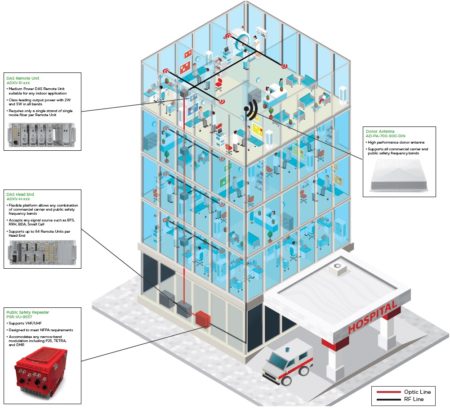WHILE SMART CITIES TECHNOLOGIES RAMP UP GLOBALLY modern life and modern work patterns increasingly keep people tethered—both by choice and necessity—to their smart devices. The old adage that states that “time is money” in the 21st century ought to up-dated to “time of connectivity is money.”
Unfortunately, stayed connected to cellular networks can be significantly challenging in today’s rapidly evolving urban environment. This is where ADRF (Advanced RF Technologies, Inc.) comes into play, producing technologies that enable advanced “in-building” wireless solutions that keep people connected during business as usual or during emergency-based situations.
Connectivity Challenges
Most of us likely experience a cellular signal drop on our smartphone at least a couple of times a week if we are moving about like the average person. We tolerate it and gripe. But in many enterprise, industrial, and first-responder contexts such drops can’t be tolerated or make or break situations.
Take physicians working at hospitals. “Now that physicians have their own practices, they obviously have their own phones and they need to be in constant contact with their offices,” says Greg Najjar, Director of Businesss Development at ADRF, “so they tell the hospital ‘if I don’t have phone signal, I can’t work there.’ ”
This is just one example of many, within multiple markets, where ADRF is installing wireless technology solutions to keep people connected. The core problem is that inside buildings, stadia, and infrastructure—like transportation tunnels—cellular signals weaken and disappear and that is simply untenable in the modern context.
Now that physicians have their own practices, they obviously have their own phones and they need to be in constant contact with their offices, so they tell the hospital ‘if I don’t have phone signal, I can’t work there.’
The drivers compounding these challenges vary, but the first primary detriment to cellular signal strength is material density. As buildings get larger or go underground, cellular signals cannot penetrate multiple concrete floors, foundations, and landmass underground. A secondary but emerging issue with respect to modern architecture is low-E glass utilized in today’s newest buildings. Designed to keep out, or in, ultra-violet (UV) spectrum rays that transmit heat energy, low-E glass feature coatings that disrupt the transmission of higher frequency radio bands. So the coatings in the new glass skyscraper you may wishfully want to move your company’s offices to may, in fact, confront your workers with cellular-connection issues.
Finally, advancing building and safety codes increasingly require more, not less, public safety communication systems within larger structures. Police, fire, EMT and other first-responders operate specific radio bands for their own communications and safety codes governing public safety communications systems ensure that first responders have signals for their own bands in areas like stairwells and elevator shafts and mechanical spaces deep inside structures. “In a commercial system you typically need about 95% coverage LTE Reference Signal Receiver Power coverage throughout a building for the carriers,” says Tim Breeman, Senior DAS Engineer at ADRF. “For public safety buildings, you need 99% coverage that includes stairwells, elevator shafts, and mechanical rooms.”
Solving the Cellular Challenges
ADRF solves all these challenges and future-proofs for others with their suite of DAS (distributed antenna system), repeaters, and antenna hardware solutions.
The way the systems work is a donor antenna is positioned in strategic exterior location and supports all commercial carrier and public safety frequency bands, including upcoming bands new to 5G. This is wired (RF line) to a DAS head-end and, or, a public safety repeater unit, often low in the building in a communications equipment space. From there DAS remote units are distributed throughout the building at different floors or locations and hard-wired using an optical line. The optical line connects the DAS units, speeding the delivery of connection communications, while ceiling-mounted antenna on each floor, project the wireless signal that keeps users always connected. Exact configurations vary on building type and situations. A single donor antenna can be the point-connection to commercial carriers and public safety bands and yet feed the overall system throughout multiple discreet and separate buildings. (see images below).

ADRF’s diagram explains how their cellular technology works inside and among several buildings. (Advanced RF Technologies / Architosh. All rights reserved.)
ADRF’s DAS unit is a 5U unit that fits into a common data server rack, along with other building communications or AV equipment. “We are modular, you can support the bands you need from day one, and we are future-proofing so you can add other bands in the future,” says Greg Najjar, of ADRF.
The antenna layouts inside buildings vary based on what bands are being supported. “The higher the bands the more dense the network is going to be because the higher bands are less effective at transmitting through as many spaces and especially less effective through materials,” adds Tim Breeman, of ADRF.
Looking at the 5G Question
This brings up the 5G question. For some consumers the very notion that 5G carries a bigger number than 4G implies that the band frequency for 5G is higher. But that is not necessarily the case. “It depends on who is providing the 5G—what carrier,” says Breeman. “If you are talking Sprint, they are using the 2.5 GHz band, if you are talking T-Mobile they will likely using 600 MHz or millimeter wave.”
On the often misunderstood issue of 5G safety, Breeman says: “Any band can technically support 5G technologies and carriers are utilizing bands that have been used for years, such as 600-2700 MHz, so there shouldn’t be a concern. The software designers of network planning platforms, such as iBwave and RanPlan, also have limits set to make sure a system is within the FCC’s RF exposure guidelines. As new bands (3.5 and 28/39 GHz) are added, these safety RF exposure limits will also be updated.”

A picture of the ADXV Series rack-mountable unit. This unit is capable of transporting frequencies from 600 – 2600 MHz plus VHF and UHF regardless of protocol or modulation. It also ensures that all public safety bands in the US and Canada are supported.
Breeman reiterates how the higher bands are often the ones being impacted by the newer low-E glass in urban skyscrapers so this is something that architects designing buildings need to discuss with their communications consultants and vice versa while a building is being designed.
Najjar says that part of the issue too is that newer buildings with low-E glass in tight urban environments are creating disruptions through reflecting RF (radio frequency). He mentioned that the software called RanPLAN that simulates RF environments can provide decision support in the design and development process.
Closing Comments
Najjar says that while there are many market segments where their company is growing the commercial real estate segment is among the strongest. “There is just a lot of people working there,” he adds, “their need for coverage is outstripping the cellular carriers’ ability to support every building.”
Part of the challenge is the increased load on networks in the era of IoT (Internet of Things) where more equipment—in addition to more people’s smartphones and devices—are talking to the Internet. Smart Cities and Smart Buildings require constant Internet connnections, and this is drivig up demand for better and faster networks inside buildings.

An image of a Healthcare installation model, showing how ADRF’s equipment is typically deployed throughout and outside a building. (image: Advanced RF Technologies / Architosh. All rights reserved.)
When I asked Greg about WiFi and its future in competing with 5G he had this to say: “From our perspective, there are several issues that come into account with WiFi,” he says. “Currently, the celluar networks are moving at a much faster pace than the public WiFi networks, and even LTE today is faster than most public WiFi networks.” Another issue is that WiFi requires stopping and connecting through a web window and sign-in process. People love the always on and seamlessness of cellular connections and 5G is just going to be so much faster.
Currently, the celluar networks are moving at a much faster pace than the public WiFi networks, and even LTE today is faster than most public WiFi networks.
“We just need several high-profile systems for clients in urban environments,” says Najjar, “and they don’t generally have WiFi systems anymore, just a guest WiFi system. They asked for a cellular network. Hudson Yards in New York City is a perfect example.”
ADRF is responding to the demands of the market and the evolving communications technologies that are behind more intelligent and always connected people and infrastructure. “From a connectivity standpoint…we just amplify the cellular signal from your provider so the connection to your devices are always on,” says Najjar. “So as you go from building to building, in and outside and back in again, your device just stays connected the whole time. This is the future-ready solution that we provide.”
[Editor’s note: Image of New York City, 2014, copyright, Daniele Pieroni, Wikipedia Commons]




Reader Comments
Comments for this story are closed